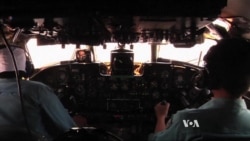On March 8, 2014 a Malaysia Airlines flight took off from Kuala Lumpur enroute to Beijing. All transmission from the plane ended 40 minutes after take-off. The plane has not been found and is presumed to have crashed into the ocean. Exactly what happened and whether this type of incident could occur again remain unresolved issues.
“Good night -- Malaysian 370.” Those were the last words heard from a Malaysia Airlines plane before it vanished from radar. A year later, the plane and the 239 people on board have not been found.
U.S. commercial airline pilot Captain Ian Gebow said the traditional 30-minute to 60-minute communication between plane and ground needs to be constant when planes are over wide bodies of water when radar is sparse. "What we really need is real-time data tracking for when an act occurs," he said.
"We are creating a generation of pilots who are monitors, as opposed to professional aviators ... a generation of pilots who use automation as a crutch rather than an aide," said Gebow.
ICAO seeks changes
The International Civil Aviation Organization [ICAO], which sets global standards for the airline industry, is recommending that planes report their positions every 15 minutes and every minute during distress.
Less than an hour after MH 370 departed Kuala Lumpur to Beijing, all communication from the plane ceased, and it dropped off radar. The first search area was along the original flight path. But the search areas kept shifting, especially after Malaysian military radar found a final transmission further north -- and that the plane could have flown another seven hours.
The discrepancy exists because traditional radar does not track over oceans, and the plane was only equipped to report its location every 60 minutes.
ICAO Council President Olumuyiwa Benard Aliu spoke via Skype. "Once we implement this system and we're able to track flights every one minute, that will increase our ability to locate flights."
"Again, I can say this organization is one of 191 member states. We set global standards for harmonized implementation. It is necessary for us to get all our members to agree to a particular standard that we have to put in place," said Aliu.
Better technology
Underwater devices searched the ocean floor for MH370, hoping to hear a signal from the flight data recorders. But the recorder batteries only last 30 days. The US Federal Aviation Administration and other global organizations are extending the battery requirements to 90 days, effective in five years.
This also is a problem. Search vehicles heard pinging sounds they thought were coming from the plane, but were actually from marine life. Former FAA Accident Investigator David Soucie has written a book on MH370.
He suggests the frequency be changed. “...So that it’s a distinguishable pattern. It’s a pattern that may be able to have a Morse Code situation that tells us what aircraft it actually came from or at least that was from an aircraft,” he said.
Experts also suggest unsinkable flight recorders.
“If you get it floating on the surface,with some sort of locator, both visually and by electronic means, I think that will both expedite the recovery process and also save millions upon millions of dollars in the search,” said Captain Gebow.
Already the MH370 search is the most expensive in aviation history -- estimated at more than $90 million.
"It's a matter of how much money you want to spend to find an aircraft that has crashed in the middle of the ocean," said Soucie.
Experts agree missing aircraft are rare, but could happen again. They say the probability drops once all this new technology is installed on new planes. That will happen seven years from now.







